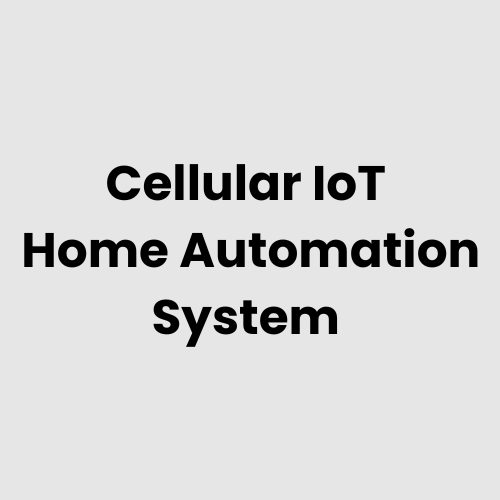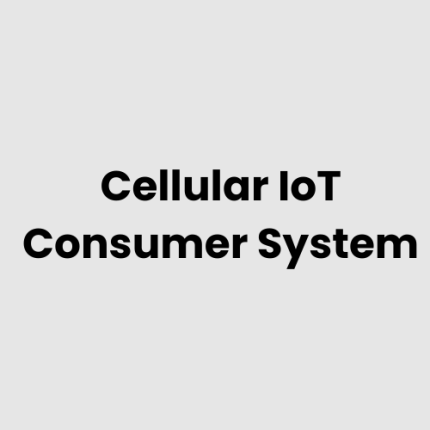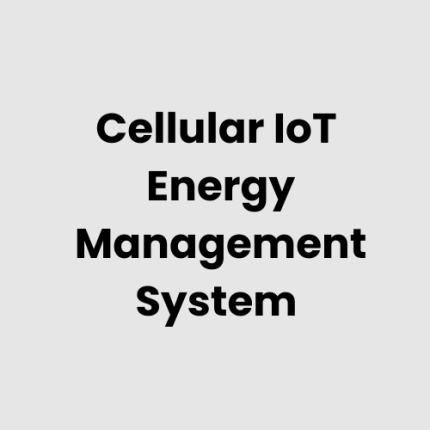Description
Technical Architecture of Cellular IoT Enabled Home Automation System
The Cellular IoT Enabled Home Automation System integrates a range of interconnected devices that communicate through cellular networks to provide smart home functionalities. It includes sensors, controllers, actuators, and gateways, all of which communicate via cellular data protocols (such as LTE, 5G) to ensure seamless home automation. The architecture consists of multiple layers: the device layer, communication layer, data processing layer, and user interface layer.
- Device Layer: Consists of smart devices like lights, thermostats, sensors, and security cameras that collect data and perform actions.
- Communication Layer: Facilitates connectivity between devices using cellular network protocols, ensuring reliable, long-range communication.
- Data Processing Layer: This layer processes the collected data and performs actions or sends alerts to users via cloud or local servers.
- User Interface Layer: Provides user-friendly dashboards accessible via mobile apps or web browsers for control and monitoring of the system.
Hardware of Cellular IoT Enabled Home Automation System
The hardware components of the Cellular IoT Enabled Home Automation System include:
- Smart Sensors: Temperature, humidity, motion, door/window, gas, and smoke detectors.
- Smart Actuators: Light bulbs, smart locks, automated blinds, and smart appliances.
- IoT Gateway: A cellular-based gateway that connects the smart devices to the cloud or local server.
- Controllers: Devices like voice assistants or smartphone apps used to control and interact with the system.
- Power Supply: Backup batteries and power adapters to ensure continuous operation.
- Connectivity Modules: Cellular communication modules (e.g., 4G, 5G) to enable seamless data transmission.
Physical Placement Considerations of Hardware
When installing the Cellular IoT Enabled Home Automation System, proper placement of hardware is essential for optimal performance:
- Sensors: Place motion sensors in hallways, near doors/windows, and in rooms where temperature or humidity needs to be monitored. Smoke detectors should be installed near kitchens and in hallways.
- Actuators: Install smart light bulbs and plugs in accessible locations for easy control, while smart locks should be installed on doors for security purposes.
- Gateway: The IoT gateway should be centrally located in the home to ensure it receives a strong cellular signal and can relay data to the cloud or local server effectively.
- Controllers: Devices such as voice assistants or smartphones should be placed in areas that are most convenient for user control.
Hardware Architecture of Cellular IoT Enabled Home Automation System
The Cellular IoT Enabled Home Automation System follows a modular hardware architecture that allows for scalability and easy integration of new devices:
- Smart Devices: Sensors, actuators, and appliances are all modular, with each device functioning autonomously while communicating with others in the system.
- IoT Gateway: Acts as a bridge between the cellular network and home devices, aggregating data and sending it to the cloud or local server.
- Local Server: In some cases, a local server may be used for processing data and controlling devices directly within the home, bypassing cloud reliance for faster response times.
- Cloud Connectivity: Data is transmitted to the cloud for analytics, storage, and remote control access.
Deployment Considerations of Cellular IoT Enabled Home Automation System
The deployment of the Cellular IoT Enabled Home Automation System involves the following key considerations:
- Network Coverage: Ensure the cellular network provides adequate coverage in all areas where devices are installed. Depending on the range, LTE or 5G coverage may be preferred for better reliability.
- Power Requirements: Backup power options like batteries or UPS should be included to ensure the system remains operational during power outages.
- Security: Implement strong encryption for data transmission to ensure privacy and protect from cyber threats. Secure authentication protocols should be used for user access.
- System Scalability: The system should be scalable to easily add new devices or expand functionality, allowing homeowners to add devices as needed.
- Integration: Ensure compatibility with other smart home platforms and third-party devices to allow a cohesive smart home experience.
List of Relevant Industry Standards and Regulations
- ISO/IEC 27001 (Information Security Management)
- IEEE 802.15 (Wireless Personal Area Networks)
- FCC Regulations (Federal Communications Commission)
- UL 294 (Standard for Access Control Systems)
- CE Marking (Conformité Européenne for European Market)
- RoHS (Restriction of Hazardous Substances)
- IEC 62443 (Industrial Communication Networks Security)
- GDPR (General Data Protection Regulation) for data privacy
- ETSI EN 300 220 (Short-Range Devices) for wireless communications
Local Server Version of Cellular IoT Enabled Home Automation System
The Cellular IoT Enabled Home Automation System can also be configured with a local server setup, allowing users to manage their home automation without relying on cloud services. The local server:
- Allows real-time control and monitoring of devices within the home.
- Provides local data storage for increased privacy and security.
- Reduces dependency on an external internet connection, ensuring the system continues to function even during internet outages.
- Offers faster response times for device actions since the server is located on-site.
Cloud Integration and Data Management
Cloud integration for the Cellular IoT Enabled Home Automation System enables seamless remote monitoring and control from anywhere:
- Cloud Platform: Devices are connected to a cloud platform that aggregates data, processes it, and provides actionable insights. The cloud also stores data for historical analysis and backup.
- Data Management: Data is securely transmitted from IoT devices to the cloud via cellular networks. This data is encrypted to ensure privacy. The system allows users to access real-time information and receive alerts about system status or security breaches.
- Remote Access: Users can control devices remotely through a web interface or mobile application, giving them the ability to adjust settings, monitor performance, and receive notifications.
- Analytics: Cloud platforms offer powerful analytics tools to optimize energy use, predict maintenance needs, and improve system efficiency based on collected data.
GAO Tek Inc., with its experience in providing innovative IoT solutions, can support your home automation needs, ensuring robust performance, seamless cloud integration, and secure data management. Our Cellular IoT Enabled Home Automation System is designed to bring efficiency, security, and comfort to modern living spaces. For more details, visit our websites: GAO Tek, Cellular IoT Devices, Healthcare IoT Applications, IoT Healthcare Devices, GAO RFID Healthcare Solutions, and GAO RFID Systems.
GAO Case Studies of Cellular IoT Enabled Home Automation System
- New York City, NY
A smart home solution was deployed in a high-rise apartment complex, integrating cellular IoT technology to automate lighting, temperature control, and security systems. The system offers seamless control via mobile apps, enabling residents to adjust settings remotely while receiving real-time alerts about security breaches and system status. Learn more about cellular IoT devices. - Los Angeles, CA
In a suburban neighborhood, cellular IoT-enabled smart thermostats and security cameras were installed in multiple homes. The system automatically adjusts heating and cooling based on real-time occupancy data, while security cameras provide remote monitoring, enhancing both energy efficiency and safety for homeowners. Explore more about IoT systems. - San Francisco, CA
A luxury home in San Francisco was equipped with a full suite of IoT devices connected via a cellular network. Automated window treatments, climate control, and energy management systems were integrated, allowing homeowners to manage their property remotely for enhanced comfort, security, and energy conservation. Read more about healthcare IoT devices. - Chicago, IL
A large-scale smart home system was implemented in Chicago, featuring sensors for motion detection, air quality monitoring, and smart lighting controls. The system allows users to track environmental conditions and adjust settings automatically, enhancing both comfort and energy efficiency while ensuring real-time notifications of potential issues. Discover more about smart lighting. - Dallas, TX
In a tech-savvy residential community, GAO Tek’s cellular IoT devices were deployed to automate the lighting, security, and entertainment systems in homes. The system is designed to reduce energy consumption by optimizing lighting and HVAC systems based on usage patterns, offering a highly efficient, low-maintenance solution. Learn more about IoT in utilities. - Seattle, WA
Cellular IoT-enabled smart appliances, such as refrigerators and washing machines, were integrated into homes in Seattle. These devices allow users to control household tasks remotely, monitor usage patterns, and receive notifications for maintenance or optimal use, offering both convenience and energy savings. See more about IoT sensors. - Miami, FL
A high-tech home in Miami adopted a cellular IoT-enabled system to optimize home security and energy management. This system integrated smart cameras, motion sensors, and automated climate control, providing enhanced safety, energy efficiency, and seamless control through a mobile app. Check out more on IoT in environmental applications. - Austin, TX
A major residential project in Austin implemented cellular IoT technology for smart home automation. Sensors monitor everything from water usage to air quality, enabling residents to optimize their home environment for health, comfort, and energy savings while receiving real-time alerts and suggestions. Read more about Zigbee technology. - Boston, MA
In a Boston-area smart home, an advanced cellular IoT system was integrated to monitor and control various home functions, such as lighting, heating, and security. This system not only optimizes energy usage but also enhances convenience by allowing users to control their home remotely via their smartphones. Learn more about IoT in the transportation and warehousing industry. - Denver, CO
A new housing development in Denver utilized cellular IoT technology for smart home automation. Sensors monitor everything from water usage to air quality, enabling residents to optimize their home environment for health, comfort, and energy savings while receiving real-time alerts and suggestions. Explore satellite GPS for IoT in safety and security. - Phoenix, AZ
In Phoenix, a residential complex adopted GAO Tek’s cellular IoT-enabled security and energy management system. The system includes smart locks, motion detectors, and energy-efficient lighting that is controlled remotely, allowing homeowners to manage their property’s security and energy consumption with ease. Check out IoT development kits in utilities. - Washington, DC
A smart home solution was deployed in Washington, DC, utilizing cellular IoT technology to integrate advanced heating, cooling, and security systems. The system provides energy-efficient home automation while allowing residents to monitor and adjust their home settings remotely via a user-friendly app interface. Explore more on IoT sensors in utilities. - San Diego, CA
A family home in San Diego implemented GAO Tek’s cellular IoT solutions to automate various household functions. Automated window blinds, lights, and HVAC systems were connected to the IoT platform, ensuring optimal energy use and enhanced comfort for the family with minimal manual intervention. Learn more about smart home solutions. - Philadelphia, PA
A smart home system using cellular IoT devices was installed in a historic Philadelphia townhouse. The system integrated smart thermostats, water leak detectors, and security cameras, providing homeowners with remote monitoring capabilities and automated energy management, reducing both costs and environmental impact. Explore more on IoT in urban planning. - Orlando, FL
In Orlando, a smart home automation system was deployed featuring cellular IoT-enabled energy management, lighting controls, and security systems. The system adapts to the homeowner’s daily routine, reducing energy costs while ensuring high levels of security through real-time alerts and remote control features. Learn more about IoT systems in utilities. - Toronto, ON
In Toronto, a residential building adopted a cellular IoT-enabled home automation system to control lighting, temperature, and security. With remote access capabilities, residents can adjust settings based on their preferences, enhancing comfort and energy efficiency while reducing their carbon footprint. Explore more about IoT platform systems. - Vancouver, BC
A smart home project in Vancouver integrated cellular IoT devices for automated home management. The system connected lighting, temperature, and security devices, offering homeowners the convenience of controlling and monitoring their home remotely while improving energy efficiency and overall security. See more about IoT solutions in healthcare.
Navigation Menu for Cellular IoT
- Cellular IoT Accessories
- Cellular IoT Devices
- Cellular IoT – Cloud, Server, PC & Mobile Systems
- Cellular IoT Resources
Navigation Menu for IoT
- LORAWAN
- Wi-Fi HaLow
- Z-WAVE
- BLE & RFID
- NB-IOT
- CELLULAR IOT
- GPS IOT
- IOT SENSORS
- EDGE COMPUTING
- IOT SYSTEMS
Our products are in stock and can be shipped anywhere in the continental U.S. or Canada from our local warehouse. For any further information, please fill out this form or email us.
We are looking for partners. For more information on partnering with GAO, please visit Partner with GAO Tek Inc. It lists various ways to partner with GAO, such as OEM Partnerships, Technology Integration, Distribution and Reselling Opportunities, Presenting at the Leading Event Tek Summit, Joint R&D Projects, Training and Consulting Services, Industry-Specific Collaborations, Research and Academic Partnerships.



